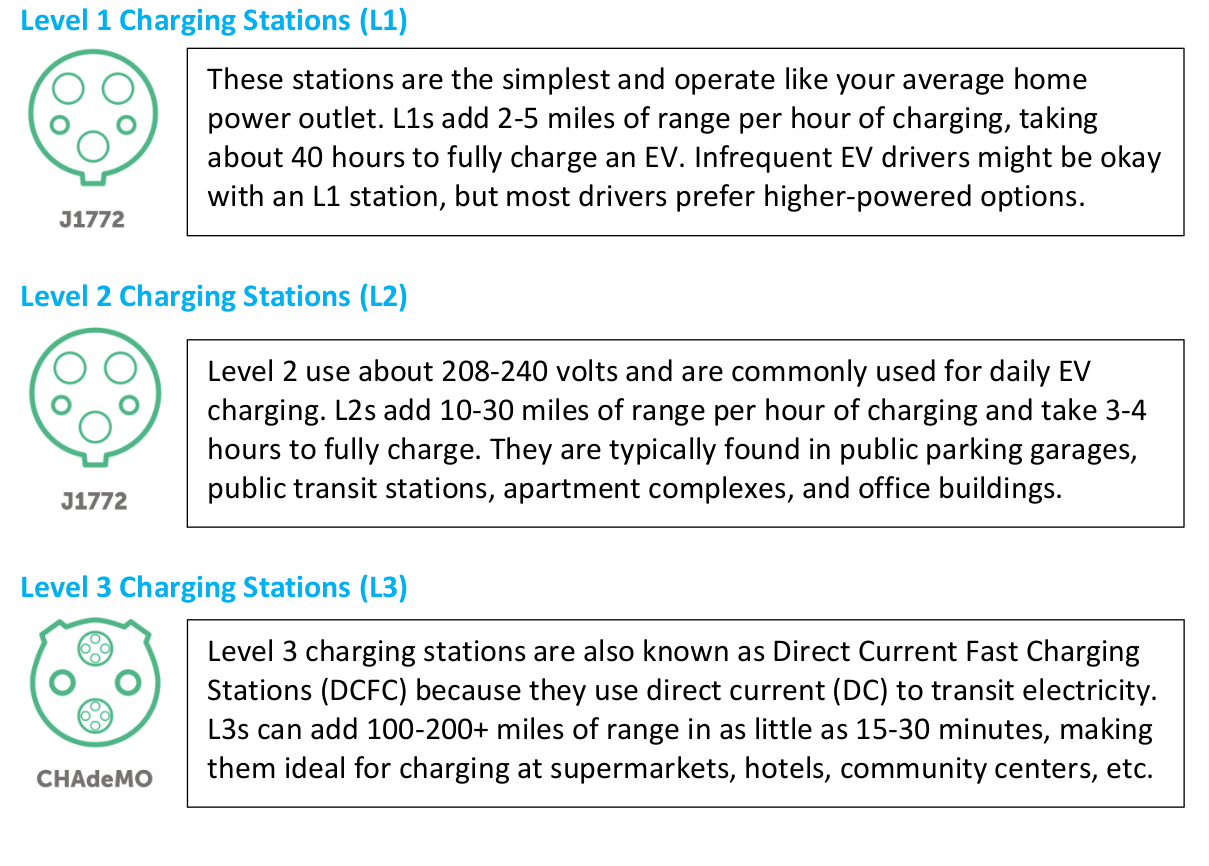Funded by the US Department of Energy, M.A.E.P. is a $14.6 million project designed to create a regional EV ecosystem in the District of Columbia, Maryland, Virginia and West Virginia. It will connect the Mid-Atlantic Region’s cities through EV infrastructure sub-projects including multimodal hubs such as airports, seaports, and logistics centers. It will also address educational, planning, and equity issues of populations near these hubs. The goal is to install approximately 200 EV charging units over 3 years through 2024.
Metropolitan Washington Council of Governments (COG’s) new Electric Vehicle (EV) Deployment Clearinghouse provides a suite of tools & resources to aid localities as they work to facilitate EV adoption. Learn more about the resource and how it can help achieve regional climate goals: https://bit.ly/43uRIUy
Charging Forward Toolkit Released to Help Urban Communities Build Charging Infrastructure

The US DOT in collaboration with the US DOE and the Joint Office, released a free technical resource to help larger communities take full advantage of federal funding for EV charging stations and other forms of electric transportation. It follows the Rural EV Toolkit released last year and updated earlier this month. The new guide is called Charging Forward: A Toolkit for Planning and Funding Urban Electric Mobility Infrastructure. It provides a comprehensive resource for communities, metropolitan planning organizations (MPOs), transportation providers, businesses, and property owners and developers by including information on how to scope, plan, and identify ways to best leverage billions of dollars in funding from President Biden’s Bipartisan Infrastructure Law.
Key Project Metrics
3 Year Project Timeline
$14.6 Million Project Budget
25 Project Partners
8.7 Million in Cost Shares
375 Charging Stations
25 Educational Events
Benefits created Between Mississippi River and Appalachian Mountains
84,861,203 Gallons of Gasoline Saved
370,332 Tons of Greenhouse Gases Reduced
31,505 Alternative fuels in use in Tennessee
(In conjunction with our partner Tennessee Clean Fuels since 2003 [https://www.tncleanfuels.org/])
FAQ
Who qualifies for a free charging station?
This project will support inter- and intra-city routes for commercial and government fleets, consumers, and ride shares in the following locations:
- Hotels
- Airports
- Schools
- Ports
- Service agencies
- Religious centers
- Workplaces
- Tourism destinations
A large component of the project is focused on outreach and improving air quality in undeserved communities in the Mid-Atlantic Region. Leading outreach efforts is EVNoire, an award-winning organization, focusing on e-mobility, transportation, energy and environmental equity.
Project partners within the Argonne National Laboratory are using a graphical instrument in order to analyze the geographical locations, where facilities such as charging stations are needed immediately. To look more into this instrument, The Energy Zone Mapping Tool(EZMT) you can use the following links; https://ezmt.anl.gov/ OR https://evsgeoportal.evs.anl.gov/portal/apps/webappviewer/index.html?id=5b78fa2849ad447dbe1fe8c3fcb5fdda for direct access.
Why consider an electric vehicle (EV)?
- A federal tax credit of $2,500-$7,500 may be available for some EV purchases. Learn more here
- EVs cost less to operate, so the higher initial vehicle cost can be offset over the lifetime of a vehicle
- Electric drive-trains are very efficient, and electricity is much cheaper than gasoline or diesel fuel
- Because they use little or no gas, EVs minimize or even eliminate trips to the gas station. Most drivers find they can primarily charge at home or work
- All-electric vehicles are driven solely by one or more electric motors powered by energy stored in batteries. This makes battery electric vehicles (BEVs) very low maintenance, which saves on costs
- EVs provide instant torque, resulting in a fun, fast, and quiet driver experience!
Why consider a hybrid electric vehicle (PHEV)?
- PHEVs use batteries to power an electric motor and use another fuel, such as gasoline, to power a conventional engine
- PHEVs produce fewer emissions than conventional vehicles because of their increased fuel economy. In all-electric mode, they produce no tailpipe emissions just like all-electric vehicles.
What incentives are in place for EVs?
Visit afdc.energy.com/laws to identify local incentives and regulations related to alternative fuels and vehicles, air quality, fuel efficiency, and other transportation-related topics in your area.
Electric Vehicle (EV) and Fuel Cell Electric Vehicle (FCEV) Tax Credit
District of Columbia Laws & Incentives
What about safety and maintenance?
EVs and their battery packs undergo the same rigorous safety testing as conventional vehicles sold in the United States and must meet Federal Motor Vehicle Safety Standards. Because PHEVs have a conventional engine, their maintenance requirements are similar to those of conventional vehicles. BEVs have fewer maintenance requirements because they have fewer moving parts and fluids to change, and their electrical systems require minimal maintenance. A manufacturer’s battery warranty typically covers 8 years/100,000 miles. Expected battery lifetime is 10-12 years under normal operating conditions. Check with your vehicle’s manufacturer for vehicle and battery warranty information.
How far can I go on a charge?
The distance an EV can travel on a single battery charge is known as its “all-electric range.” All-electric vehicles can typically go 100 to 400+ miles on a single charge.
PHEVs can typically go 15-50 miles on battery power alone; their overall range is determined by the fuel tank capacity because the engine kicks in when the battery is depleted.
Several factors affect actual range, including driving conditions, driving habits, and use of climate controls.
Where can I charge?
Most EVs come with a 110-volt “Level 1” cord set that can be plugged in to a typical household outlet. For quicker charging, homeowners can install a 240-volt L2 unit—often with little or no required electrical upgrades since most homes have 240-volt service for appliances like dryers and electrical ranges. More and more workplaces are also installing charging units or making 110-volt outlets available to employees and visitors. MAEP will make EV chargers increasingly available in public spaces.
To find existing fueling stations in your area, use the Department of Energy’s
Alternative Fueling Station Locator tool via https://afdc.energy.gov/stations/#/find/nearest?fuel=ELEC
Questions? Please contact
Antoine Thompson
antoinethompson@gwrccc.org
Project Partners





